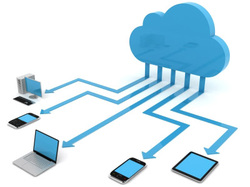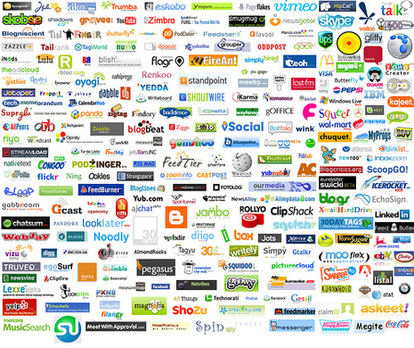
The concept of collaboration is not new. For centuries people have consulted each other and brought ideas together for a common purpose. However, what has changed is the way in which it is being done.
Today, people located at different parts on the globe are able to meet online and share ideas in real time. This has opened many doors within the realm of education to both students and teachers. Services such as: AgreeAdate, TimeToMeet, ActiveCollab, Zoho Chat, PageShare, Skype, Textflow and Yammer are all examples of online collaboration tools. Because of the vast number of available tools, it is important for teachers to carefully select which ones are best suited for their classroom.
Dropbox is a popular application for cloud storage and file sharing, and one that I personally use frequently. One of the benefits of Dropbox is that, once files are uploaded, they can be remotely accessed from computers, as well as mobile devices. Booker (2013) notes how Dropbox offers four great features, which include: sharing stores files, overcoming email limitations, turning in homework, and easy saves from popular apps. With Dropbox, files can be sent to people with the click of a button and shared folders can be created with ease. In addition, Dropbox offers 2GB of initial storage space, which is significantly more than Uleth's webmail service (50 MB). Furthermore, Booker (2013) explains how Dropbox is great for homework, because teachers can share assignments with students, and students can hand in their work, which includes a time-stamp feature. Lastly, Booker (2013) notes that many popular apps, such as Evernote, offer a Dropbox "sync" option that makes saving documents simple and easy.
I think Dropbox has a number of benefits that make it an ideal application for the classroom. It's simplicity, size and functionality allow for easy collaboration and file sharing. THIS ARTICLE by Jennifer Carey (2012) outlines ways to use Dropbox with students with step-by-step instructions, and even includes screenshots of the process.
Google Drive is another application that focuses on collaboration. It can be a powerful tool within the classroom because of its many features and possibilities. For instance, Google Drive allows students to simultaneously work on a Word document or PowerPoint from different computers. Although there are some concerns about using Google Drive and privacy, the potential benefits of using Google Drive outweigh the risks.
One of the ways Google Drive can be implemented within the classroom is through Word document collaboration. For example, in a Language Arts class multiple students can team up to write a short story or poem together. Similarly, in a Math class students can view the same spreadsheet and make changes to it together. In Social Studies or Science, Google Drive allows multiple users to work on the same presentation. My experience with Google Drive in the past has been a positive one. In a few of my Education classes I have used it for writing documents with group members, as well as creating presentations. However, Google Drive offers possibilities that extend beyond just this.
Google Drive can be used as a means for peer-assessment between students. Hardison (2012) describes how he used the features of Google Drive within his classroom, and includes a breakdown of his lessons within this article. Hardison (2012) explains how he used Google Forms as a place for students to give feedback, and Google Spreadsheet as a way for students to check submissions. Hardion's incorporation of Google Drive into his lessons highlights the many possibilities of this application. It is a multi-faceted tool that can pique student interest and extend their learning through non-traditional means.
Another Google application that is gaining traction within academic circles is Google Hangout. Google Hangout offers a platform for teachers and students to engage in online communication and collaboration. The TeachThought staff offer 32 tips for using Google+ Hangouts in the classroom. Some of these tips include: monitoring comments, staying on topic, setting the length of the session, and being adequately prepared. Google Hangout also offers possibilities for students.
Between students, Google Hangout can be used as a forum to talk about class and give feedback to one another. It can also serve as a place where students collaborate on projects or assignments. Between classrooms, Google Hangout can be used as a place where presentations are shared and ideas as discussed. Students could come up with a set of instructions beforehand and ask other classes what they are doing in theirs. In Science classes, Google Hangout can be a way in which classes share experiments with one another and share their findings. However, despite the possibilities of this application, there are also risks.
One of the risks of Google Hangout is privacy. When users sign up to Google+ the settings on their profile set everything to public view. Unless users change their privacy settings everything they do will be accessible to public eyes. Another risk of using Google Hangout is operator error. Although it is not overly complicated, users need to be proficient at using the features of the application. It is for this reasons that I think Google Hangout is more appropriate for high school students. Online collaboration and independent learning is more of a quality that high school students possess, as opposed to elementary or junior high students. However, it could be used in an elementary setting if the whole class was involved, with the teaching leading. Similarly, it could be used in a middle schools or junior high class with more mature students, or as enrichment. However, regardless of the grade level it is important to inform parents because it is an online tool.
I would send parents an email or letter letting them know the basics of Google Hangout, as well as its educational value. I would also set up a Google Hangout one evening for parents to join and try it out for themselves. This way they would be aware of what the application is all about, as well as its possibilities.
The number of collaboration mediums reflect the countless possibilities that exist within the context of education. As cloud computing and collaboration continues to grow, so will the number of ways in which it can be used effectively. However, it is important to be selective in what applications are used, as well as how they are used within the classroom. If cloud computing and collaboration is used appropriately both teachers and students can benefit from the many features these applications have to offer.
References
Fig.1. Collaboration-Cloud.jpg. Retrieved July 13, 2013. From http://activeco.com/wordpress/wp-content/uploads/2012/09/Collaboration-Cloud.jpg
Booker, Ellis. (2013, April 3). Dropbox in the Classroom: 4 Great Uses. Retrieved from
http://www.informationweek.com/education/admin-systems/dropbox-in-the-classroom-4-great-uses/240152140
Carey, Jennifer. (2012, August 10). Using Dropbox in the Classroom. Retrieved from http://plpnetwork.com/2012/08/10/dropbox-a-superb-classroom-tool/
Hardison, John. (2012, December 26). The Sidekick & the Superhero: Using Google Drive for Peer-Assessment. Retrieved from http://gettingsmart.com/2012/12/the-sidekick-the-superhero-using-google-drive-for-peer-assessment/
TeachThought Staff. (2012, October 18). 32 Tips for Using Google+ Hangouts in the Classroom. Retrieved from http://www.teachthought.com/technology/32-tips-for-using-google-hangouts-in-the-classroom/
Significant Comments:
http://aroseduc4764.weebly.com/1/post/2013/07/the-internet-and-collaboration.html#comments
http://jillianmacdonald.wordpress.com/2013/07/17/topic-7-collaboration/#comments
Today, people located at different parts on the globe are able to meet online and share ideas in real time. This has opened many doors within the realm of education to both students and teachers. Services such as: AgreeAdate, TimeToMeet, ActiveCollab, Zoho Chat, PageShare, Skype, Textflow and Yammer are all examples of online collaboration tools. Because of the vast number of available tools, it is important for teachers to carefully select which ones are best suited for their classroom.
Dropbox is a popular application for cloud storage and file sharing, and one that I personally use frequently. One of the benefits of Dropbox is that, once files are uploaded, they can be remotely accessed from computers, as well as mobile devices. Booker (2013) notes how Dropbox offers four great features, which include: sharing stores files, overcoming email limitations, turning in homework, and easy saves from popular apps. With Dropbox, files can be sent to people with the click of a button and shared folders can be created with ease. In addition, Dropbox offers 2GB of initial storage space, which is significantly more than Uleth's webmail service (50 MB). Furthermore, Booker (2013) explains how Dropbox is great for homework, because teachers can share assignments with students, and students can hand in their work, which includes a time-stamp feature. Lastly, Booker (2013) notes that many popular apps, such as Evernote, offer a Dropbox "sync" option that makes saving documents simple and easy.
I think Dropbox has a number of benefits that make it an ideal application for the classroom. It's simplicity, size and functionality allow for easy collaboration and file sharing. THIS ARTICLE by Jennifer Carey (2012) outlines ways to use Dropbox with students with step-by-step instructions, and even includes screenshots of the process.
Google Drive is another application that focuses on collaboration. It can be a powerful tool within the classroom because of its many features and possibilities. For instance, Google Drive allows students to simultaneously work on a Word document or PowerPoint from different computers. Although there are some concerns about using Google Drive and privacy, the potential benefits of using Google Drive outweigh the risks.
One of the ways Google Drive can be implemented within the classroom is through Word document collaboration. For example, in a Language Arts class multiple students can team up to write a short story or poem together. Similarly, in a Math class students can view the same spreadsheet and make changes to it together. In Social Studies or Science, Google Drive allows multiple users to work on the same presentation. My experience with Google Drive in the past has been a positive one. In a few of my Education classes I have used it for writing documents with group members, as well as creating presentations. However, Google Drive offers possibilities that extend beyond just this.
Google Drive can be used as a means for peer-assessment between students. Hardison (2012) describes how he used the features of Google Drive within his classroom, and includes a breakdown of his lessons within this article. Hardison (2012) explains how he used Google Forms as a place for students to give feedback, and Google Spreadsheet as a way for students to check submissions. Hardion's incorporation of Google Drive into his lessons highlights the many possibilities of this application. It is a multi-faceted tool that can pique student interest and extend their learning through non-traditional means.
Another Google application that is gaining traction within academic circles is Google Hangout. Google Hangout offers a platform for teachers and students to engage in online communication and collaboration. The TeachThought staff offer 32 tips for using Google+ Hangouts in the classroom. Some of these tips include: monitoring comments, staying on topic, setting the length of the session, and being adequately prepared. Google Hangout also offers possibilities for students.
Between students, Google Hangout can be used as a forum to talk about class and give feedback to one another. It can also serve as a place where students collaborate on projects or assignments. Between classrooms, Google Hangout can be used as a place where presentations are shared and ideas as discussed. Students could come up with a set of instructions beforehand and ask other classes what they are doing in theirs. In Science classes, Google Hangout can be a way in which classes share experiments with one another and share their findings. However, despite the possibilities of this application, there are also risks.
One of the risks of Google Hangout is privacy. When users sign up to Google+ the settings on their profile set everything to public view. Unless users change their privacy settings everything they do will be accessible to public eyes. Another risk of using Google Hangout is operator error. Although it is not overly complicated, users need to be proficient at using the features of the application. It is for this reasons that I think Google Hangout is more appropriate for high school students. Online collaboration and independent learning is more of a quality that high school students possess, as opposed to elementary or junior high students. However, it could be used in an elementary setting if the whole class was involved, with the teaching leading. Similarly, it could be used in a middle schools or junior high class with more mature students, or as enrichment. However, regardless of the grade level it is important to inform parents because it is an online tool.
I would send parents an email or letter letting them know the basics of Google Hangout, as well as its educational value. I would also set up a Google Hangout one evening for parents to join and try it out for themselves. This way they would be aware of what the application is all about, as well as its possibilities.
The number of collaboration mediums reflect the countless possibilities that exist within the context of education. As cloud computing and collaboration continues to grow, so will the number of ways in which it can be used effectively. However, it is important to be selective in what applications are used, as well as how they are used within the classroom. If cloud computing and collaboration is used appropriately both teachers and students can benefit from the many features these applications have to offer.
References
Fig.1. Collaboration-Cloud.jpg. Retrieved July 13, 2013. From http://activeco.com/wordpress/wp-content/uploads/2012/09/Collaboration-Cloud.jpg
Booker, Ellis. (2013, April 3). Dropbox in the Classroom: 4 Great Uses. Retrieved from
http://www.informationweek.com/education/admin-systems/dropbox-in-the-classroom-4-great-uses/240152140
Carey, Jennifer. (2012, August 10). Using Dropbox in the Classroom. Retrieved from http://plpnetwork.com/2012/08/10/dropbox-a-superb-classroom-tool/
Hardison, John. (2012, December 26). The Sidekick & the Superhero: Using Google Drive for Peer-Assessment. Retrieved from http://gettingsmart.com/2012/12/the-sidekick-the-superhero-using-google-drive-for-peer-assessment/
TeachThought Staff. (2012, October 18). 32 Tips for Using Google+ Hangouts in the Classroom. Retrieved from http://www.teachthought.com/technology/32-tips-for-using-google-hangouts-in-the-classroom/
Significant Comments:
http://aroseduc4764.weebly.com/1/post/2013/07/the-internet-and-collaboration.html#comments
http://jillianmacdonald.wordpress.com/2013/07/17/topic-7-collaboration/#comments



 RSS Feed
RSS Feed